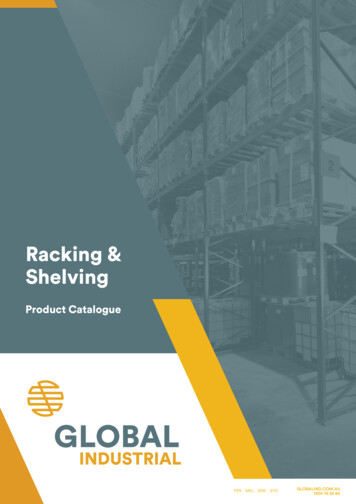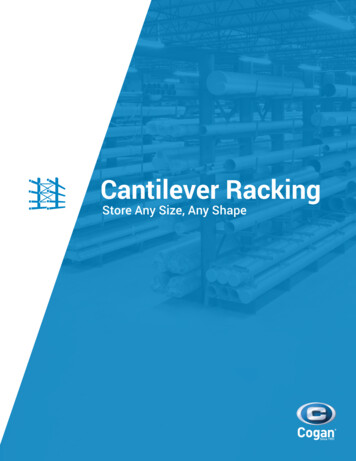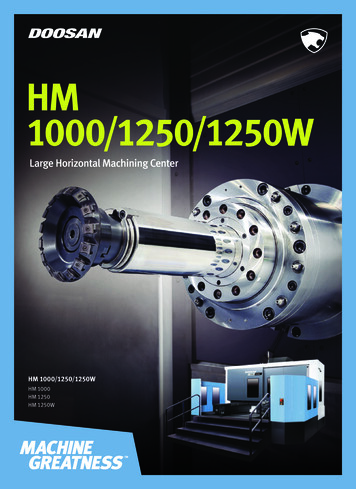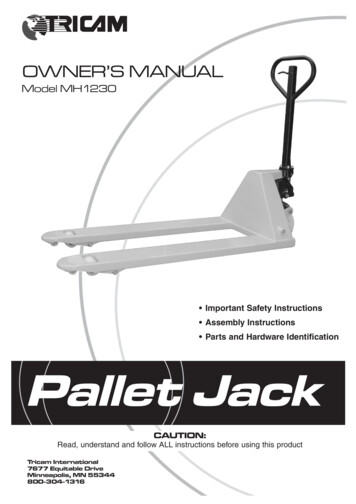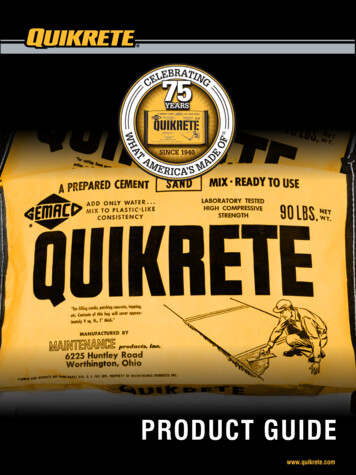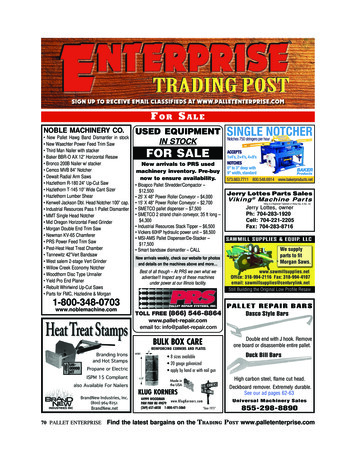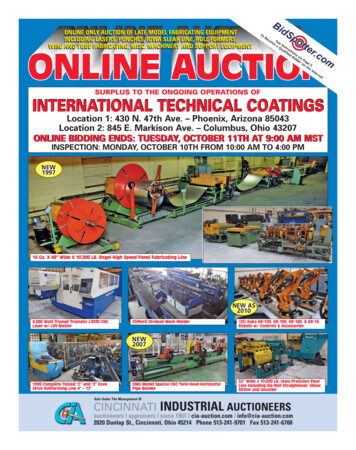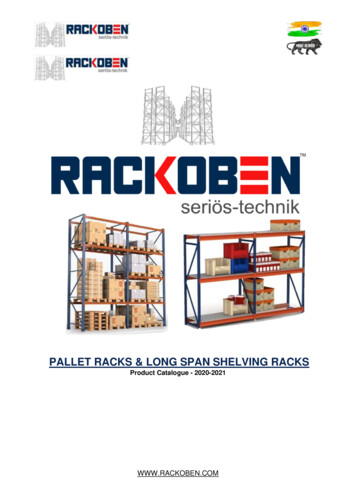
Transcription
Pallet racking use and maintenance guideOperation, use, review and maintenance of conventional pallet rackingfacilitiesEdition 01—June 2016
CONTENTS:Pág.0. Introduction . . 31. Scope . . 42. Normative references . 43. Terms and definitions . . 54. Elements . . . 85. Storage system configuration . . 126. Assembly . . 187. Advise on utilisation . . . . 228. Inspections and maintenance . .23ANNEX A. Supplier responsability . . . 31ANNEX B. Load signal example . . . 32KIMER ESTANTERÍAS. USE AND MAINTENANCE GUIDE2
0.INTRODUCTION:This guide, based on EN 15635 Steel static storage systems, application and maintenance of storage equipment, gives guidelines for operational aspects relevant to structuralsafety of storage systems. Such systems opérate with heavy mechanical handling equipment working in close proximity to static storage equipment. This minimizes the risk andconsequences of unsafe operation or damage to the structure.This manual will fit stores where units of load, usually palletized or in containers, arehandled by forklift trucks or other equipment maintenance, so we will remove risks frommanual loading in stores.The use of a conventional shelving installation should be done under some minimmum attention requirements in order to avoid accidents that can cause:High cost service interruptions.Insecure working conditions.Damaged products, useless shelves or even environmental problems.A rational and secure use of the installation is achieved with close collaboration between shelving manufacturers, machine manufacturers, shelving owners and employees.All instructions and recomendations from manufacturers should be strictly followed. It isalso strongly recommended to follow any type of planned activity that considers:Prevention damaged parts on the shelving.Frequent inspection of shelving conditions.Employee training.All information required to prepare planned activities is exposed and explained on furtherpages. They all comply with UNE-EN 15635 as regards manually loaded installations,being completely prohibited the loading or unloading with any mechanical aid.VERY IMPORTANT! Surveillance, use and installation conditions are customers responsibilities. Customers should advise and train effectively all future workers of the warehouse.All images shown can just be considered as examples and can never be used as a matterof future complaints.KIMER ESTANTERÍAS. USE AND MAINTENANCE GUIDE3
1.SCOPEKIMER ESTANTERÍAS has produced this manual in order to:Advise clients to provide each of the installations of conventional shelves for palletized load (APR), the safety and quality of the work necessary for the use of thesame.Lay the foundation so that the user can make their prevention plans and the assessment of the conditions present in your installation of conventional shelves for palletized load.This document must be applied in conjunction with the Standards EN 15512, EN 15620,EN 15629, EN 15635, EN 15878 y UNE 58013.This manual applies to all equipment storage, manufactured in steel, which are active orin use, and in any area of storage (distribution centers, industrial, commercial, etc.)This manual excludes storage equipment manufactured from materials other tan Steel(except for certain accessories) and equipment intended to be used for domestic storagepurposes.2.STANDARDS FOR CONSULTATIONThe standards listed below are indispensable for the application of this document.- EN 15512, Adjustable pallet racking systems. Principles for structural design.- EN 15620, Adjustable pallet racking. Tolerances, deformations and clearances.- EN 15629, Specification of storage equipment.- EN 15635, Application and maintenance of storage equipment.- EN 15878, Terms and definitions.- UNE 58013, Steel static storage systems. Requirements for treatment of damaged components.KIMER ESTANTERÍAS. USE AND MAINTENANCE GUIDE4
3. TERMS AND DEFINITIONS:3.1 APR (adjustable pallet racking); Steelwork structure consisting of frames andbeams adjustable in height, specifically designed to support pallets and unit loads.3.2 Bay load: Total allowable weight of all the unit loads in a bayof racking not includingany unit loads that may be stored on the floor of the bay.3.3 Compartment load: Load which can be loaded into one compartment of a racking orshelving structure frome one side3.4 Counterbalanced forklift truck: Ride-operated type of forklift truck that carries itsload cantilevered forward of its front main wheel axle and is stabilized with a counterweight at the rear of the truck.NOTE: This type of truck is a general-purpose truck and may be used in wide-aisle pallet racking systems3.5 Design clearances: Nominal dimensión ítems used in the design.NOTE: These clearances enable input and output of the load to take place without contact of the load withany other loads or part of the storage system structure other tan normal contact when the load is placed onthe beams or other members provided for its support in storage.3.6 Double deep racking: Racking in which pallets can be stored two deep from one aisle into the installation and accessed by a specially adapted long reach fork mechanism.3.7 Drive in racking: System of racking that provides blocks of storage where pallets arestored two or more deep and Access is gained by driving a lift truck into a lane with pallets supported along their sides on beam rails supported from the uprights.3.8 Drive throught racking: System of racking that provides blocks of storage where pallets are stored two or more deep similar to DIR except that the truck can be driven into alane on one side of the block and out of the other if there are no obstructions.3.9 Frame load: Total allowable weight of all the unit loads transmitted to the frame bythe members attached to the frame3.10 Hand pallet truck: Small hand-operated truck used for moving pallets around on level floors and the pallet is lifted clear of the floor by raising and lowering a tiller bar operates a hydraulic lifting device.3.11 Intrusive stacking: Placement or retrieval of a pallet where the turning radius orlength of a lift truck is greater than the aisle width and part of the pallet storage convernedis used by the truck forks and load when turning to place or retrieve a pallet.3.12 Mechanical handling equipment MHE: Mechanical equipment used to transportthe unit load to be stored.3.13 Mezzanine floors RSA: Additional floor above the ground floor slab level used forstorage which can be free standing or attached to the building structure.3.14 Narrow aisle racking: Pallet racking arranged in a similar way to wide aisle rackingbut having aísles of a reduced width for use with more specialist types of lift trucks.KIMER ESTANTERÍAS. USE AND MAINTENANCE GUIDE5
3.15 Pallet: Portable platform, with or without superstructure, for the assembly of a quantity of goods to form a unit load for handling and storage by mechamical appliances.3.16 Pallet buffer back stop: Buffering back stop, which is specified as an aid for use byforklift truck drivers to deposit a unit load in the correct position in the racking.3.17 Pallet safety back stop: Safety back stop to prevent accidental collision of a palletor its load with other unit loads or equipment, when that load is placed in the storage compartment.Type a) safety device, which protects against unintentional load movement within the racking and prevents loads from protruding or from falling into an aisle or into an area accesible to people.Type b) backstop to prevent accidental damage, usually placed at the back of a storagecompartment, to prevent the accidental collision of a palet or its load with other equipment, such as sprinklers, when a load is placed in the storage compartment.3.18 Pick up and deposit stations, P and D stations: Storage locations at the end of anaisle used as an interface between different types of mechanical handling equipment.NOTE: The P and D stations can be used as an interface between the unit load and handling equipmentthat is dedicated to the rack aisle (such as very narrow aisle (VNA) trucks or cranes) and the conveyors orfree movements trucks which service the installation. The P and D stations can also be used to accuratelyfiz the location of the unit load relative to the racking. This is often used by trucks or cranes having a fixedlength of fork stroke and ensures accuracy in the X and Z directions when placing the unit load onto the racking beams.3.19 Powered hand pallet truck: Small hand-operated truck used for moving palletsaround on levels floors where the power for lifting and moving the pallet loads is providedby a battery and electric motor.3.20 Reach truck: Stacking lift truck with outriggers where the load can be repositionedby moving the mast or fork arm carriageNOTE: These trucks are generally used in narrow aisle racking because their overall length is less tan acounterbalanced lift truck of the same lifting capacity3.21 Shelving: Persona o empresa que proporciona al proveedor las especificacionesbasadas en los requisitos del usuario.3.22 Specified allowable unit load: Unit load allowed in the storage equipment.3.23 Specifier: person or company that provides the supplier with a specification basedon the user s requirements.NOTE: The specifier can be a consultant or other specialist, the end or the equipment supplier acting as thespecifier.3.24 Storage equipment: Structure used to store the unit loads.3.25 Straddle-type stacker trucks: Manually or electrically operated pallet trucks withstraddle legs.KIMER ESTANTERÍAS. USE AND MAINTENANCE GUIDE6
3.26 Supplier: Company that supplies the storage equipmentNOTE: The company may be the original manufacturer or an intermediate company acting as a distributor.3.27 Total racking or shelving load : Total allowable load supported by all the primaryload supportingNOTE: This may be the total load from beams or shelves in a defined área of racking or shelving.3.28 Unit load: Weight of an individual stored ítem that can be placed or retrieved in theoperation.3.29 User: Company or person who manages and operates the installation on a daily basis and is responsable for the continuing safety of the installation3.30 Very narrow aisle racking VNA racking: Pallet racking arranged with aísles of awidth to cater only for the truck and the unit load width plus an operational clearance where the truck cannot make 90º turns into the rack face for loading and off loading.3.31 Very narrow aisle truck VNA truck: Rider operated fork lift truck which can work inaísles only slightly wider tan the truck or the unit load carried and is fitted with a fork mechanism permitting Access on either side of the aisle without turning the main body of thetruck.NOTE 1: VNA trucks are normally guided within the aísles. Because of the accuracy required in placing pallets into the racking, these trucks usually pick the pallet loads up from a specially designed P & D station atthe entrance to each aisle.NOTE 2: A VNS truck is sometimes known as a Turret Truck.3.32 Wide aisle racking: Pallet racking arranged to leave aísles of sufficient width toallow the forklift truck equipment to traverse the length of the aisle and to make 90º turnsinto the rack face for loading and off loading.3.33 90º stacking: Placement or retrieval of a pallet where the forklift truck makes a 90ºturn to face the rack during the placement or retrieval process.NOTE: In making this turn, no part of the truck or load intrudes into the racking.KIMER ESTANTERÍAS. USE AND MAINTENANCE GUIDE7
4. ELEMENTS4.1 Palletised goodsPalletracking systems are designed to store palletised goods, containers or non– palletised goods. For each category, sufficient data must be furnished allowing the rackingsupplier designing the racking correctly.It is understood by palletised good a palette composed whole unit plus load. Measured byits total weight.These goods are different forms and are made of different materials:Wooden palletMetallic or plastic palletContainerThe construction of any of these platforms must meet the following requirements:ISO and EN Standards.Be capable of supporting the deposited load.Fit with the model set out in the original design of the installation.Wooden palletMetallic palletContainerKIMER ESTANTERÍAS. USE AND MAINTENANCE GUIDE8
The actual dimensions of the unit loads shall not adversely affect the clearances providedfor safe operation.The pallets are defined in the following standards:EN 13382: Flat pallets for materials handling. Principal dimensionsEN 13698-1: Pallet production specification - Part 1: Construction specification for800 mm x 1200 mm flat wooden palletsEN 13698-2: Pallet production specification - Part 2: Construction specification for 1 000mm x 1 200 mm flat wooden pallets4.2 Floor of the buildingThe user is responsable for confirming the suitability of the intended floor or foundation forthe loads being imposed upon it by the racking. The standard load tables take into account that the floor is solid concrete, min. 120mm thick and with a mínimum strength ofclass C20/25 fck 20N/mm² (EN 1992). If the floor is made from other materials, such abituminous compounds, the racking supplier must be informed as special consideration isneeded.The floor flatness is given by the document EN 15620KIMER ESTANTERÍAS. USE AND MAINTENANCE GUIDE9
4.3 Materials handling equipmentMechanical, electromechanical equipment carried out by lifting are loading and unloadingin storage systems, at the same time serving to transport the goods.The most commonly used on shelves are:Stacker: Chauffeured aboard or at ground level.Counterbalanced forklift: three and four-wheeledReach truck: counterbalanced with retractable mastHigh-rise carts: are divided into trilateral, bilateral and order pickersHigh rack riser truck: For automatic installations.StackerBilateralCounterbalancedReach truckTrilateralThe choice of one or another element will be conditionedby the following data warehouse:SizesCorridors wideMax lifting heightMax lifting loadKIMER ESTANTERÍAS. USE AND MAINTENANCE GUIDEHigh rack riser truck10
4.4 Racking classes According to EN-15620,Class 100: Pallet racking arranged as for a very narrow aisle system but operatedby a stacker crane. The aisles are wide enough only for the stacker crane or loadwidth plus operational clearance as shown in figure. The stacker cranes are automatically controlled, do not have a fine possitioning system at the unit load storage positions and are usually for storage systems less than 18m in height.Class 200: Crane operated installations where the stacker cranes are automaticallycontrolled and have fine positioning system at the unit load storage positions. Alsoincludes installations where the stacker crane is manually controlled.Clase 300: Class very narrow aisle pallet racking is arranged with aisles of a widthto cater only for the truck and the unit load width plus operational clearance. The unitloads are handled within the aisles without the need for the truck to turn bodily intothe rack face. The trucks are usually guided into and along the aisle length by guiderails or a wire guidance system and have fixed or rising cabs.Class 300A: Very narrow aisle installations class 300A are where the truck operatoris raised and lowered with the unit load and has manual height adjustement to position the load man-up. Alternatively, the operator remains at ground level and has theuse of an indirect visibility aid such as circuit television (CCTV) or an equivalent system to guide the operator.Class 300B: Very narrow aisle installations Class 300B are those where the truckoperatoor remains at ground level, mandown, and does not have the use of an indirect visibility aid.Class 400:Class 400 Wide aisle: Wide aisle racking is arranged to leave aisles of sufficientwidth to allow fork lift truck equipment to traverse the length of the aisle and make90º turns into the rack face for loading and off loading.Class 400 Narrow aisle: Estantería de carga paletizada con pasillo reducido, quepuede ser usada por carretillas más especializadas.This use and maintenance manual will deal only with conventional pallet racking shelving.KIMER ESTANTERÍAS. USE AND MAINTENANCE GUIDE11
5. DESCRIPTION OF THE OF SHELVES:A system of conventional shelves for palletized load (APR) consists of alignments of racksplaced vertically and connected to each other by pairs of beams which, in turn, are spacedin high enough to accommodate the intended load units.Designed implementation may not vary in any of its aspects (loading, geometry units.)without consulting with the KIMER Department technician.It is expressly forbidden:Changing levels in heightModifying the number of levels (even preserving the load for casting)Modification of profilesUse of the installation with damage on main elements (frames, beams, safety pins,braced.)Use the installation when it detects a desaligned in one of the frames.KIMER ESTANTERÍAS. USE AND MAINTENANCE GUIDE12
5.1 In relation to security, we must emphasize the following elements:Protections:According to standard UNE 15512, impacts on posts on the shelves with a proper formation of the forklift operator and through the adoption of security measures, which includethe use of guards should be avoided.As a minimum must be protections in posts on the corners located in the corridors of circulation or at junctions of corridors where the trucks change direction.Protections must have a minimum height of 400mm and be able to absorb energy from atleast 400Nm in any direction and at any height between 100 and 400 mm as it set forth inthe attached on 15512.Pallet stop:Profile located so that the palette (never the load) is in contact constantly with the same.The function of this profile will be resist the efforts of positioning. At the same time shelvingmust be designed to absorb them.KIMER ESTANTERÍAS. USE AND MAINTENANCE GUIDE13
5.2 Manipulation of the charging unitThe elements that compose a conventional rack for pallet racking have been calculated towork in normal operating conditions, i.e. with static charges.These conditions are not given if trolley with its load give rise to bumps, collisions, pushes,pulls, positioned sudden load. (see annex D) The deformation, sometimes, can be accompanied by damage to the connector and fall of the beam and its load.Positioning of the charging unit:When there are more than two units of load per level it is recommended to place the endsfirst to have a reference of positioning of the pallets.The pallete has to be placed on the beams with sufficient surface área and with thesupports well placed.It must avoid a concentration of load in the middle of the beams, approximating thepalletes, otherwise it will appear unacceptable deflections.KIMER ESTANTERÍAS. USE AND MAINTENANCE GUIDE14
Avoid the eccentricity of load relative to the position of the beams, otherwise, the more loaded beam will present more deflection than the right one.Avoid pallets with non distributed load. Its effect is an increase of the deflection.Avoid falls and sitting sudden load. It can lead to permanent deformation of thebeam.Drag or horizontal push when positioning the load can cause turns and drags inbeams.Sudden elevations can damage the top beam. However, safety pins prevent it to unlock.Eccentricity on a beamPalette with uneven loadNo horizontal descent of the loadDrag or horizontal thrustKIMER ESTANTERÍAS. USE AND MAINTENANCE GUIDE15
Work clearancesObserve the minimum clearances established in the norm at 15620Height H fromground to beamlevelClass 400Class 300AClass 300BXYXYXY0 H 3.0007575757575753.000 H 6.000751007575751006.000 H 9.000751257575751259.000 H 12.000100150757510015012.000 H 13.0001001507575100175KIMER ESTANTERÍAS. USE AND MAINTENANCE GUIDE16
Horizontal gaps in depth without back stops.Observe the minimum clearances established in the norm at 15620KIMER ESTANTERÍAS. USE AND MAINTENANCE GUIDE17
6. ASSEMBLY. ASPECTS TO TAKE INTO ACCOUNT:To ensure safe use of the equipment for storage, we will attend to:A)Storage equipment must be mounted according to the specification, drawings andthe detailed assembly instructions provided by the supplier.B)CHARACTERISTICS: The load capacity of the installation, which must be well knownand respected.These features should not be altered. Any change, modification or enlargement, requires study and express authorization from the supplier.C)LOAD: The maximum weight, the type of load and its stability must be known andrespected:D)The ground should have the right strength, stiffness, leveling and flatness for use;E)Facilities must have warning load plates, given by the supplier, indicating therein sufficient information related to the type and characteristics of load, as well as safetywarnings. This plate must always be in a place visible shelving or next to it.F)It is advisable to identify the corridors, in order to quickly locate a certain area of theinstallation with any damage in the elements.G)PRSES security officer must ensure that the stated maximum load level is not exceeded.H)End user shall be responsible for ensuring, during the routine use of the installation,the correct use according to the directions of the supplier and also the damage produced to the installation.I)The store where the shelves are placed will be suitable, it is recommended that thestore has adequate lighting, appropiated ground and corridors are free of obstacles.KIMER ESTANTERÍAS. USE AND MAINTENANCE GUIDE18
All the shelves must be fixed to the ground with suitable anchors according to the directions of the supplier and must be mounted according to the instructions of the supplierof the anchorsIn the case of conventional shelves of double alignment must be mounted at leasttwo spacers. The position of the spacer must be as close as possible from the knot of theframe to avoid local damage to the upright by bending. The number and the position mustmeet the following minimum requirements (see fig. 1):1)Lower spacer next to the lower knot of the frame.2)Highest spacer next to the higher knot of the frame .3)If necessary, close the upright joint.4)When the distance between the two spacers frame cited is exceeding 3 metres, it isrecommended to place an additional spacer every 2-3 metersKIMER ESTANTERÍAS. USE AND MAINTENANCE GUIDE19
When provided vertical bracing elements, that elements may be provided to ensurethe stability of the rack, must be anchored to the ground according to the instructions ofthe supplier. They must be mounted according to the manufacturer's instructions and mustnot be removed or reset.Base plates must have its entire surface in contact with the ground of the building orother structural elements. The base plates must be level with plates of different thicknesses leveling. The gap between bases of a same frame must not exceed 1/500 of the widthof the frame.The space between beams, shelves, etc. It must not exceed the values provided bythe supplier of the shelving, which correspond to their maximum loads permissible for theframes of the shelves as shown on the rating plates.Beams must fit into place using safety pins.Warning plates (see annex B) must be located in the right place.CHANGES IN THE CONFIGURATION OF THE SHELVES:Changes may occur in the permissible load capacity when the storage equipment ismodified. In all cases of change call to the supplier or an appropriate expert and receivedinstructions must be followed before making any changes.A)the shelves must be downloaded before making any changes.B)Additions or changes in storage by welding or screwed must not be allowed unlessthey are approved by the supplier of the equipment.C)The warning plates need to be updated according to the changes.KIMER ESTANTERÍAS. USE AND MAINTENANCE GUIDE20
TOLERANCIAS DE MONTAJEKIMER ESTANTERÍAS. USE AND MAINTENANCE GUIDE21
7. CONSIDERATIONS FOR THE USE OF SHELVINGTo establish the correct use, we will attend the five fundamental aspects of the installation.1.THE CHARACTERISTICS OF THE INSTALLATION: The load capacity of the installation, which should be known and respected.2.LOADING UNITS: Maximum weight, the type of load and its stability, the dimensionsof the load and type of palette must be well known and respected.3.THE MANIPULATION OF THE LOADING UNIT: Recommendations for handling thecharging unit and the maintenance of forklifts must be known and followed.4.THE TRAINING OF THE STAFF: staff working in the facility must know the materialsyou are using and follow the established guidelines.5.STORE: The building that hosts the installation shall have the minimum requirementsfor a proper use of the shelves.KIMER ESTANTERÍAS. USE AND MAINTENANCE GUIDE22
8. MAINTENANCE AND INSPECTIONS (according UNE EN 15635)PERIODIC INSPECTIONS;The significance that may have impacts and damages not served on time is recommended that a internally periodic inspection exist at;Damage to frames and their components; uprights, base plates and diagonalsFailure of verticality in uprightsEffectiveness of the beam-upright connectionBroken welds or material next to these welded componentsTighten screw connectionsThe ground building conditionsCorrect mounting of the shelf according to the assembly instructionsOther items to check are::updated security platesThere is no overload at load positionsLoads do not overhand from the outer perimeter of the alveolusThe dimensions of loading units are satisfactoryGuideline recommended;weekly visual inspection of the lower levels (1º y 2º)More detailed monthly inspection of the other levelsAnnual inspection by competent and experienced staffImmediate notification: as soon as anyone detect security problems or damage shouldnotify immediately the PRSESVisual inspections: La PRSES must ensure that inspections are carried out weekly orother regulated intervals. You must keep and maintain a record of the inspections.Inspections by an expert: A competent person should be technically carry out inspections at intervals of not more than 12 months. A report must submit written to the PRSESwith observations and proposals for action to follow.KIMER ESTANTERÍAS. USE AND MAINTENANCE GUIDE23
CRITERIA FOR THE EVALUATION OF DAMAGE; EVALUATION OF FRAMESThese rules apply only to damage causing a general bent in an element (see fig. 14). Theydo not apply to damages punctual located such as dent, folded, tears and cracks. The folded in less than a meter can be judged is apportioned to the limits of one meter; for example, recommended limits are applied over half a meter in length. Elements with tears andcracks should reponse always. The measurement of damages must be performed as follows:A)Place a rule of 1. 0's long contact with a surface flat on the concave side of the damaged item, in such a way that damaged surface is as centered as possible, the length of the rule.B)For an upright folded in the direction of the beams, the maximum separation betweenthe upright and rule must not exceed 5.0 mmC)For an upright folded in the direction of the frame, the maximum separation betweenthe uprightand rule must not exceed 3.0 mm;D)For an upright that has been damaged in such a way that it is bent in both directions,longitudinal and lateral deformation from left to right and front to the back, should beassessed and considered separately and 5.0 mm and 3.0 mm indicated; limits shouldbe respectedE)For elements of the truss bent in any plane, the separation between the rule and thediagonal element must not exceed the 10.0mm on a stretch of pattern of length 1.0 orpro rata for shorter frames where cannot use section pattern of length 1.0 m.KIMER ESTANTERÍAS. USE AND MAINTENANCE GUIDE24
CRITERIA FOR THE EVALUATION OF DAMAGE; EVALUATION OF BEAMSTo evaluate the damage on beams:Residual vertical deformation (which remains after the unloading the beams), causedby accidental overload. It should not exceed 20% of the normal deformation underpermissible total load (L/200 under load).Residual lateral deformation. It must not exceed 50% of the deflection under full loadadmissible(L/200).Connectors that have obvious visible deformations must download and seek advicefrom an expert.The localized damage in the form of dents, cracks, etc. must be assessed in each case indoubt, download the level and change the damaged beam.Safety pins:It is imperative that all beams have placed their two safety pins. This will prevent from thataccidentally a stringer no longer catches his accommodation.KIMER ESTANTERÍAS. USE AND MAINTENANCE GUIDE25
ANOMALIES AND FAILURES. MOST COMMON RISKS:It is then exposed in a box the most common risks, effects on the shelves and the adviceto avoid them.In beams:ANOMALIES AND FAILURESCONSEQUENCESHOW TO AVOID THEMOverloadExcesive deflection.Control of the weight of loadingunits.Permanent vertical deformation andsubsequent fall.Non-uniform distribution of loadsPositioned sudden loadExcesive deflection. Permanent vertical deformation and subsequent fall.Follow the recommended guidelineExcesive deflection.Control positioning of the load.AEFEM 211-1998Risk of fall of the beam.Absence of locking pinRisk of fall of the beam.Verify the presence of safety pins.Hits with machinery or loadLateral deformations.Follow the recommended guidelineRisk of fall of the beam.AEFEM 211-1998Reduction of the useful life.Use maintenance programs to prevent corrosionsOxidation and ruined paintBreakage and subsequent fall of thebeamIn frames:ANOMALIES AND FAILURESCONSEQUENCESHOW TO AVOID THEMOverloadExcesive uprights deflectionControl of the máximum weight perbay.Buckling and torsion accusedFrame collapseHits with ma
3.11 Intrusive stacking: Placement or retrieval of a pallet where the turning radius or length of a lift truck is greater than the aisle width and part of the pallet storage converned is used by the truck forks and load when turning to place or retrieve a pallet. 3.12 Mechanical handling equipment MHE: Mechanical equipment used to transport

